-
Konnichi wa Minnasan!
(Hello Everyone!)
With June approaching I thought I might take a look at summer in our focus part of the world. Today I am going to focus on Japan since the first time I went to Japan it was August, and I can speak first hand of the weather - HOT! HUMID!! Japan has a climate similar to ours, and is considered temparate, but it does get very hot in the summer. I can recall getting up in the morning, taking a nice shower, getting ready for the day, and eating breakfast inside with the air conditioning, then heading out the door and feeling like I needed another shower after 10 minutes!
Search on Summer in Japan and a lot of information comes up. A few websites are Matcha (yes, that is Japanese for green tea), Lonely Planet (a good source on other countries in general), Nippon.Com - Your Doorway to Japan , and Live Japan . Live Japan has a LOT of info, and does focus a lot on things in and around Tokyo.I recommend checking out these sites.
There is a lot of good surfing in what I have given you, but I will give you some basics. Like I said, it gets HOT. Lightweigtht clothing and plenty of water is the rule of the day. The one caveat here is if you intend to go to a temple, bare arms is considered bad manners, so a lightweight long sleeve shirt is needed there. Oddly, you will see guys in the city running around in full suit and tie because that is still proper in the office. It is just odd when it is 95 with 90% humidity and you see a poor guy in a full suit and tie. You will also see a lot of women with long sleeves because Japanese women don't tend to be sunbathers. Keeping your skin pale is the fashion. Makeup focuses on having good UV protection - no wonder all those paper parasols you might see! For dressing up in kimonos, you will see cotton kimonos, called yukata (you-kah-tah). You may still see amazing patterns on the fabric, but these are lightweight cotton indeed. I was given one as a gift by my host family. It was white with big blue flowers all over it, and the wide belt, or obi was red.
One other part of the weather is rain. There is a roughly six-week rainy period. There are also monsoons and typhoons. You heard all about monsoons when studying about India in Global. Well, India doesn't have them all. Live Japan refers to "guerilla rainstorms", or sudden showers. Some can cause a lot of damage with flooding and landslides. Guerilla storms describe sudden downpours that bring a large amount of rain to a small area. You may recall a couple years ago that Japan had a lot of flooding. Our own sister city of Niimi had a lot of damage from the flooding. The Takahashi River goes right through downtown, and even though there are flood control measures in place with a channel for the river bordered by dikes, it is sometimes not enough.
Like here, there are a lot of outdoor activities in the summer in Japan. There are beaches, kayaking, hiking trails, sightseeing adventures, and even glamping. You've heard of glamping? Glamorous camping? Here in the States there are many glamping places now where you get a platform with a big tent on it. Inside is actual furniture - a real bed, some chairs, a woodstove for cool nights, etc. Most are sure to have the platform big enough so that there is space outside the tent like a deck with Adirondack chairs. Well there is glamping in Japan too - one place mentioned was Hakuba near Nagano.
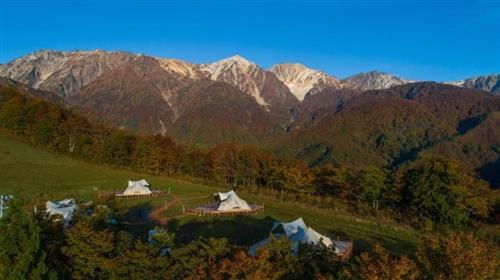 Glamping in Hakuba near Nagano. You can see the Japanese "Alps"
Glamping in Hakuba near Nagano. You can see the Japanese "Alps"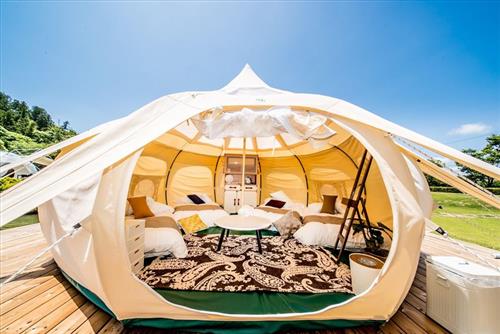 Glamping
GlampingOne place to hike is up Mt. Fuji. Mt. Fuji is over 2 miles high so be prepared for a 3.776 km trip! Summer is peak hiking time here so the trails are crowded, but imagnine the view! Some folks like to climb overnight so that they can see the sunrise.
 Hiking up Mt. Fuji
Hiking up Mt. FujiThere are a lot of fun Summertmie festivals in Japan in the summer. Festivals mean parades, food, and fireworks. In Japan fireworks are called hanabi (hah-nah-bee), which literally means fire flowers. The two biggest festivals in Japan are Tanabata and Obon. Tanabata I was told is in August, but everywhere I looked refers to July 7. The date is supposed to be the 7th day of the 7th month using a lunisolar calendar, so that would cause it to shift around. There is also a regional component to who celebrates when. The main date is July 7 is using a standard calendar. Obon in mid-August.
Tanabata is based on an old folk tale of star-crossed lovers (do I hear Romeo and Juliet?). In this case, Orihime and Hikoboshi, the Princess Weaver and the Cowherd (which comes from Chinese folklore - another thing Japan borrowed from China). They lived on either side of the Amanogawa River (the Milky Way). Now unlike Romeo and Juliet, Orihime's Dad was happy to let her marry Hikoboshi, but he was not happy when she stopped weaving beautiful silk fabrics. Plus, Hikoboshi was letting his cows wander all over Heaven. Pops got mad and took his daughter back across the river, and there was no bridge. Dad was keeping them apart so Orihime would get back to weaving - remember, they are married! Of course Orihime was crying all the time and Dad felt badly, so he said if she kept up with her weaving, they could be together on the 7th day of the 7th month. Of course, no bridge. So a group of magpies flew in an formed a bridge. If it rains on Tanabata, the magpies cannot fly, so that year the lovers cannot be together.
Looking at a folk tale, we DO have the Milky Way in the sky. And where do we find Orihime and Hikoboshi? They are the stars Vega in the northern constellatin of Lyra, and Altair found in the constellation of Aquila. Ega, Altair, and a third star, Deneb, form a triangle. Since it is about stars and the Milky Way, you often hear this called the Star Festival. The most famous Tanabata Festival is held in Sendai. It dates back to the first warlord in the area, Date Masamune (1567-1636). During Tanabata people put handwritten wishs on paper and they hang on bamboo branches.
 Tanabata
Tanabata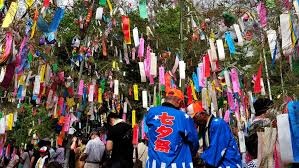 Tanabata
TanabataThe other big festival is Obon. The first time I went to Japan, my visit was to our original sister city of Osa. I compare Osa to New Paltz, including both the village and the town. You are saying, "Wait, I thought our sister city is Niimi?" Yes. In 2005 Japan was trying to cut back on levels of government so Osa was merged with 4 other towns. I can best compare it to merging New Paltz, Gardiner, Highland, Modena, and Poughkeepsie, and calling the whole thing Poughkeepsie. I mention this because my trip during Obon was in 2000 when we still focused on just Osa.
When I think of Obon I compare it to a merger of Halloween and Thanksgiving. It is a bit like the idea of Halloween in that it is believed that at this time of year the spirits of our ancestors are close to the Earth. Families hang lanterns outside their doorways to light the way home. In cemetaries people leave favorite foods and drinks on their ancestors' graves. It is also THE big travel time in Japan because everyone goes home to be with their families, just like we try to do at Thanksgiving. Over the river and through the woods, to Grandmother's house we go!
Obon in Osa has a lot going on. One night we went to a small carnival and I went fishing for goldfish. Have you ever gone to the Ulster County or Dutchess County Fairs and seen little bowls with goldfish? You try to win a fish by tossing a ping pong ball and having it land in, and stay in the bowl. In Japan it is a little different. You got a little circle with a thin piece of paper covering the circle. You have to try to get a fish on the paper without the paper breaking....not as easy as it sounds as the paper is thin and the fish is probably bouncing around trying to get back in the water. I actually did win one and had no idea what to do with it, so I gave it to my host family to put in their koi pond. There was also a little show on the stage with different acts. Afterwards we went to what seemed like a big neighborhood block party with a lot of food. At Obon there is always Japan's version of line dancing, called Obon-dori. Everyone at the party was encouraged to join in. There are a few simple steps, hand movements, clapping sometimes, and sometimes even fans are held in hands. Japan's version of the Cuban Shuffle! Someone beat on a big Taiko drum and we went around in a big circle. Another night we went to a party at the mayor's house. We walked out to the rice field to watch the town's fireworks. It was the most amazing fireworks I have ever seen, and I was impressed that this was for a small town the size of the Village of New Paltz. I commented on this and was told that eveyone in the town donated money to be able to have the show. Afterwards we went back to the mayor's house for food and a singalong.
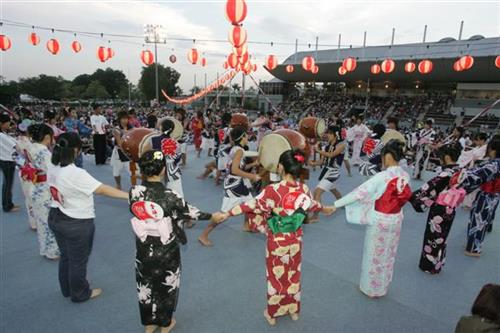 Bon Odor dancing
Bon Odor dancingWhile these are the two big festivals, there are many smaller festivals, or matsuri (mah-tsoo-ree : mush the t and s sound together). If you watched any of the Journeys in Japan shows I told you about, there were a couple about summer festivals with floats in parades, food stalls in the streets, fireworks, etc. Another big one is in Kyoto in the Gion neighborhood, the Gion Matsuri, which runs the whole month of July. There is a huge parade with floats on July 17 and a smaller parade July 24. Osaka has its Tenjin Matsuri July 24 and 25th. This is dedicated to Suguwara Michizane, the Japanese deity of scholarship and learning - ooh, as students we like learning! On the 2nd day there is a procession carrying portable shrines called mikoshi (mee-koh-shee) and people start at the Tenman-gu Shrine and end up on boats in the river. The Aomori (Ah-oh-moh-ree : this means Blue Forest) Nebuta Festival is a traditional celebration in northeastern Japan. It is famous for its parade of giant decorated floats. I am pretty sure this was on Journeys in Japan as well.
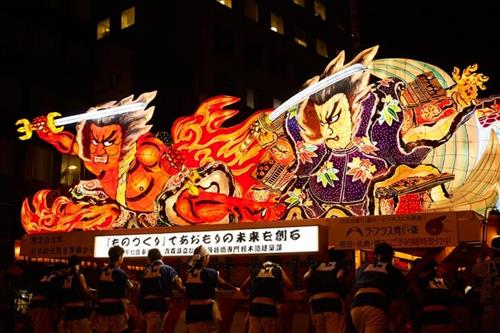 Aomori Float
Aomori FloatFestivals mean food. You can find all kinds of fried foods, and food on sticks, or skewers. Yakitori (grilled chicken skewers), yaki-soba (fried noodles), tako-yaji (battered, fried octopus pieces), okonomiyaki (fried savory 'pancakes'), and ika-yaji (grilled squid on skewers). Some of you might have said yuck a few times LOL. I am actually down with the octopus and squid! A big favorite in the summer time in Japan, festival or not, is kakigori - a hill of shaved ice flavored with sweet syrup. You can leave me at the shaved ice - flavors like strawberry, lemon, green tea, yuzu, and others - but some folks drizzle condensed milk over it, or top it with sweet beans, fruit, and a scoop of ice cream! Cold noodle dishes and kakigori are popular all summer long. I actually like to eat soba noodles - even Tops has them - a I get the broth online or at Mitsuwa to make Zarusoba. The noodle soup base is called mentsuyu (men-tsoo-yoo) and you can easily make it at home with sake, mirin, soy sauce, kombu, and dried bonito flakes. Don't get excited about the sake, the first thing you do is boil it so it looses the alcohol! However, I am lazy and when I can't get to Mitsuwa, I order noodle soup base from Amazon LOL.
Well, it is not summer quite yet, although these past few days it has felt like it. Do be sure to enjoy the nice weather!!
Ogenkide,
Mrs. S
I finally got the pictures to load! I did not take any of these personally.
Select a School...

